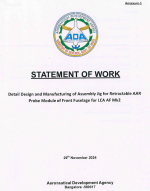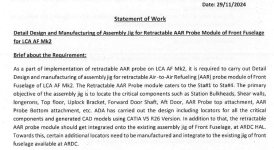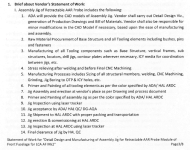@randomradio @Rajput Lion @Parthu
I remember article by indranil roy saying Mk2 nose cone diameter will be reduced but will carry same Mk1A radar..which will decrease radar cross section & improve aircraft range like that...
Last edited:
@randomradio @Rajput Lion @Parthu
I remember article by indranil roy saying Mk2 nose cone diameter will be reduced but will carry same Mk1A radar..which will decrease radar cross section & improve aircraft range like that...

Every sentence is worth a tweet..
> Mk2 endurance is 120 mins vs 57 In mk1
( Mk 2 range 3000 km with both internal & external fuel )
> Mk2 payload is 6500 kg vs 3500 kg in mk1
> MK2 manufacturing has 40 modules vs 5 in mk1. ( 25/ year production can be achieved,not sure from how many lines)
> Mk2 has internal IRST, EW vs pod in Mk1
> Mk2 has quick turnaround time
> Mk2 has health monitoring systems

Its been 6 years since this article published. Lets sink that in.
All of this was known for years now. Even the modular bit was mentioned by Saurav Jha in 2019.
Instead, for MWF, ADA is working on a modular concept in which electric looms, piping, and connectors are terminated at sub-assembly interfaces with appropriate interconnectors [18]. All the major sub-assemblies namely the three fuselage sections, wings, and the fin are also being designed with this modular approach in mind. Four Tier-1 suppliers have already been identified to take up these high-level sub-assemblies. These high level sub-assemblies are further subdivided into modular sub-sub-assemblies and so on. These, in turn which will be outsourced to Tier-2/3 suppliers. The assembly will take place using a ‘jig-less’ assembly process [3]. In this approach, the jigs are modular by design and have more versatility to adapt to any changes in the build standard of the aircraft.
View attachment 40878

All of this was known for years now. Even the modular bit was mentioned by Saurav Jha in 2019.
Instead, for MWF, ADA is working on a modular concept in which electric looms, piping, and connectors are terminated at sub-assembly interfaces with appropriate interconnectors [18]. All the major sub-assemblies namely the three fuselage sections, wings, and the fin are also being designed with this modular approach in mind. Four Tier-1 suppliers have already been identified to take up these high-level sub-assemblies. These high level sub-assemblies are further subdivided into modular sub-sub-assemblies and so on. These, in turn which will be outsourced to Tier-2/3 suppliers. The assembly will take place using a ‘jig-less’ assembly process [3]. In this approach, the jigs are modular by design and have more versatility to adapt to any changes in the build standard of the aircraft.
View attachment 40878
 cc @randomradio @Rajput Lion @Ashwin
cc @randomradio @Rajput Lion @Ashwin


". Very interesting that project director of LCA mk2 says that if Mk1 has an RCS of x then Mk2 is 1/4th of X "
Such a small reduction is not impressive in this day and age. M2000 to Rafale lowered RCS by 10-20 times in the 90s. This is a reduction of 12 times in comparison after 30 years over 2 jets.
Plus it means the opposite. To reduce radar detection by half, you need to reduce RCS by 16 times. So a 4 times reduction means it's the same airframe. TEDBF will see a far greater reduction than what Rafale achieved, 'cause that's a new airframe.
I don't know why people are hellbent on thinking Mk2 is a new airframe. CSIR-NAL was the one that conducted the study to stick plugs in the Mk1 to make it Mk2, it was publicly released as well. Original Mk2 came with a 0.5 m plug, the current Mk2 comes with 2 plugs; the original plug for the nose and a second plug behind the cockpit for more fuel, avionics, and canards. Mk2's literally the Mk1 airframe with 2 plugs and better area ruling, and with some drag and RCS refinement.
Its been 6 years since this article published. Lets sink that in.

I believe Information now has more significance as sort confirmation that design objectives are on track to be achieved.
This also confirms DDR & co infos are reliable and well ahead.
Hope they don't delay roll out first flight and certification.
And information about 3500 kg payload of mk1 instead of 4000 kg is old or latest one ?
How can you go jig-less when you need jiggys for refueling probe like itemscc @randomradio @Rajput Lion @Ashwin
View attachment 40929
View attachment 40930
View attachment 40931
It's just an observation; not saying it's irrelevant.That's nothing special. When Mk2 is inducted, the article will presumably be about 12 years old and still remain relevant 'cause Jha is a reliable journo.

It will be 4000+km. The gripen E has 4000km ferry range with similar internal fuel capacity.Every sentence is worth a tweet..
> Mk2 endurance is 120 mins vs 57 In mk1
( Mk 2 range 3000 km with both internal & external fuel )
> Mk2 payload is 6500 kg vs 3500 kg in mk1
> MK2 manufacturing has 40 modules vs 5 in mk1. ( 25/ year production can be achieved,not sure from how many lines)
> Mk2 has internal IRST, EW vs pod in Mk1
> Mk2 has quick turnaround time
> Mk2 has health monitoring systems
"The LCA-AF Mk-2 is not Tejas, it's a completely new design - structurally & systems-wise also"
But muh plugs!
@randomradio
